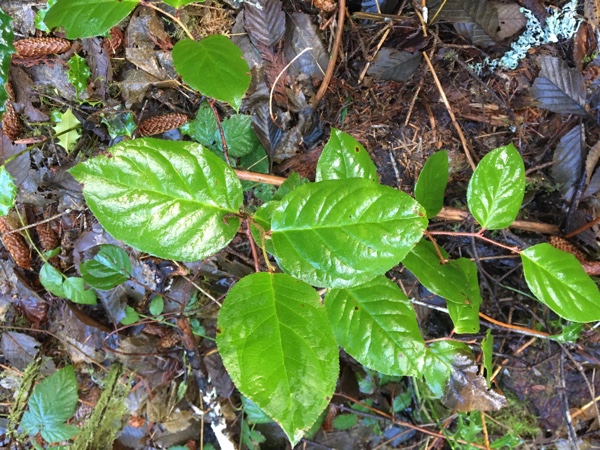
Wednesday, January 1, 2020
I spent the first day of the new year out at River Song. The tree trimmer had been out on Monday, and I was eager to see how it looked. He had trimmed the branches on the cedar in the southwest corner and “bucked” the fallen cedar in the northwest corner. Per our agreement, he let fallen branches and logs lay where they landed. It was up to me to deal with the carnage.
This is a great way to save money on tree trimming, by the way. I did this when I had my small orchard trimmed in Eastern Washington and saved half the cost.
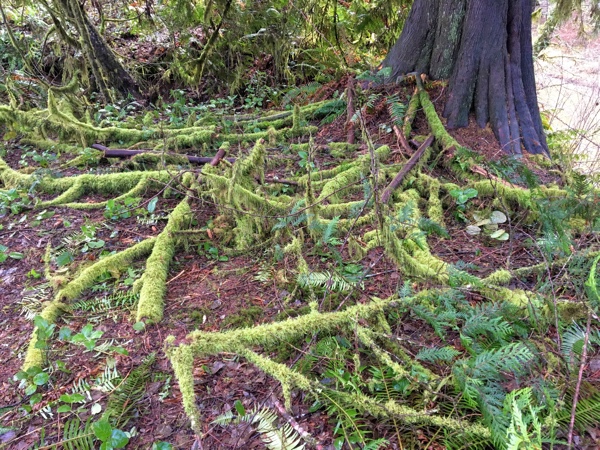 I could tell he had been there even before I got out of my truck. It had been raining hard for the past couple of days, making the ground soft, causing tires to dig ruts in the parking area. I need to get my driveway put in soon before my truck digs a trench.
I could tell he had been there even before I got out of my truck. It had been raining hard for the past couple of days, making the ground soft, causing tires to dig ruts in the parking area. I need to get my driveway put in soon before my truck digs a trench.
I backed in, changed into my work gear, and headed down the trail. Moss covered limbs from the cedar tree lay scattered on the ground. I walked over to take a closer look. Limbs still extended over the creek, adding a bit of privacy between my property and the neighbor’s house, but the lower limbs to the north and west were gone, opening up the view of the river. The difference was incredible! What a view my cabin will have!
I headed to the north end to check out the fallen cedar. The trimmer had warned me the logs had not rolled down the hill when cut, and they may present a hazard. That was a little concerning; I’m not sure how I will deal with that. I’ll figure it out.
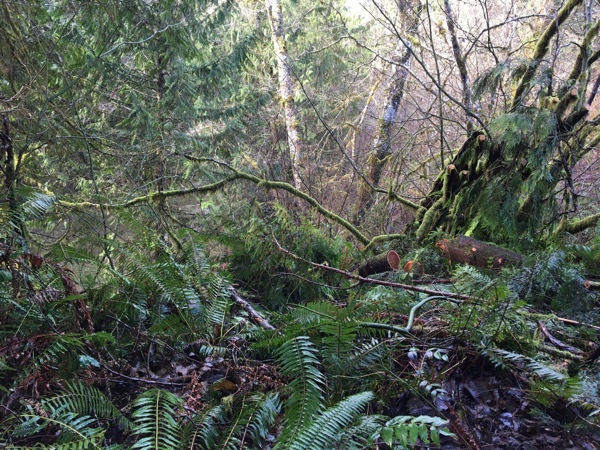 I could smell the cut cedar as I approached the north end. As with the southern end of the property, this area is now opened up to a fabulous view of the river. And, now that the cedar is cut into manageable six-foot logs, it doesn’t look nearly as daunting. I think I can move those logs by myself. First, I need to clear away the piles of branches. I’d spent the previous Saturday out here clearing away the vine maples that had been trapped underneath it, but I had only moved those to the side. They needed to be sorted and moved, too. Anything worth using as firewood, fence posts, or walkway supports would be saved; the rest would be composted.
I could smell the cut cedar as I approached the north end. As with the southern end of the property, this area is now opened up to a fabulous view of the river. And, now that the cedar is cut into manageable six-foot logs, it doesn’t look nearly as daunting. I think I can move those logs by myself. First, I need to clear away the piles of branches. I’d spent the previous Saturday out here clearing away the vine maples that had been trapped underneath it, but I had only moved those to the side. They needed to be sorted and moved, too. Anything worth using as firewood, fence posts, or walkway supports would be saved; the rest would be composted.
I checked out my path down to the bank. I had always tied my rappel line to the fallen cedar; I will have to rig up something else temporarily until I get the debris cleared out of the way and a permanent trail built. But, the bank down below was now wide open. Nothing was obstructing it; there was plenty of room for tents and a fire pit. Moreover, the tree trimmer had cut a bench into the remaining stump. Awesome! That was super sweet!
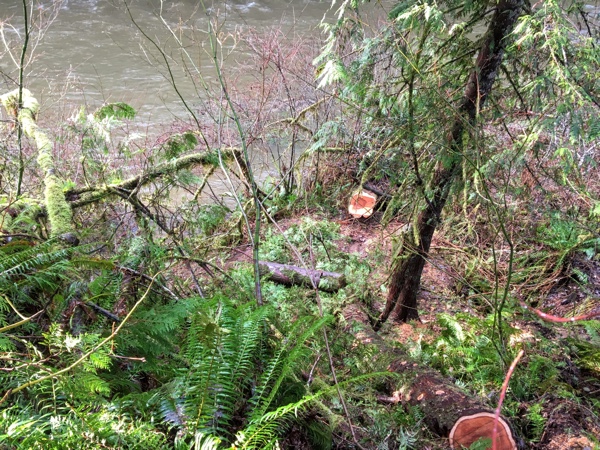 Cleaning up that debris will take several weekends. For now, I decided to just clean up the branches at the southwest corner. I hadn’t gotten much sleep the night before and I was hungry; I didn’t feel up to putting in a lot of hours today. I could do the smaller job in an hour.
Cleaning up that debris will take several weekends. For now, I decided to just clean up the branches at the southwest corner. I hadn’t gotten much sleep the night before and I was hungry; I didn’t feel up to putting in a lot of hours today. I could do the smaller job in an hour.
Unfortunately, I had damaged my chainsaw while clearing out the vine maples the previous Saturday, so I had to resort to my hatchet and folding hand saw for trimming the branches. But, I had the job done in about an hour, adding quite a bit more wood to my “keep” pile.
And….
Identifying my foliage
I’m still trying to figure out what kinds of trees I have; specifically, the difference between Douglas fir and Sitka spruce. I’m not sure which I have, or if I have both. The tree trimmer had told pointed to one and called it a spruce tree, but when I Googled it, I’m not so sure. It seems to have the bark of a Douglas fir and the needles of a Sitka spruce. So, this time I came prepared with some research and printouts, not only with information about these two trees, but also about red alder, as well. If I am to care for my trees properly and plan for their futures, I need to know what they are.
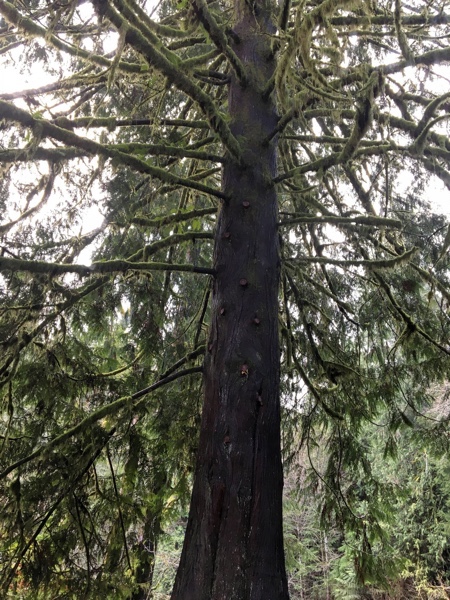 I wandered around the property, looking closely at the trees’ bark, as well as searching out cones, seed pods, leaves, and needles scattered on the ground. I know how to identify western red cedars by their scaly leaves; most of my trees are cedars. I also know how to identify hemlocks by their droopy branches and flaccid tops; I don’t have any of these. Pine trees are pretty distinguishable by their clustered needles; I don’t have any of these, either. But the identities of other trees are a bit murky.
I wandered around the property, looking closely at the trees’ bark, as well as searching out cones, seed pods, leaves, and needles scattered on the ground. I know how to identify western red cedars by their scaly leaves; most of my trees are cedars. I also know how to identify hemlocks by their droopy branches and flaccid tops; I don’t have any of these. Pine trees are pretty distinguishable by their clustered needles; I don’t have any of these, either. But the identities of other trees are a bit murky.
I looked again at the tree identified by the trimmer as a spruce. The bark was furrowed, but not really scaly. Both Sitka spruce and Douglas fir bark gets furrowed as trees age, but Sitka spruce is supposed to get scales. I wasn’t seeing that here. The needles on the lower branches were soft and not very pointy; again, more like a Douglas fir than a Sitka spruce. However, the branches felt pretty rough and and the needles were connected with nubs instead of cups. Very confusing.
But, armed with my research and printouts, I had a better idea of what to look for: cones. Douglas fir cones are very distinctive with their “mouse tails.” Sitka spruce cones, on the other hand, are long and slender and bendy. Before I headed out that morning, I picked up some branches and cones that had fallen in the RV park during the previous night’s storm, and they were definitely Douglas fir. I now had something real with which to compare my trees.
I recognized the cones immediately: Sitka spruce. I searched the entire property and didn’t find a single mouse-tail cone. No Douglas firs! My needle trees are all Sitka spruce. I did, however, find some other cones, which I gathered for identification later. These will be shown in the photos below.
In addition, I started paying closer attention to the other plants on the property. I have some vines with pointy stabby leaves. I had thought they were all the same, but after looking at them more closely, I could see very obvious differences, which I’ll also point out in the photos below.
Sitka Spruce
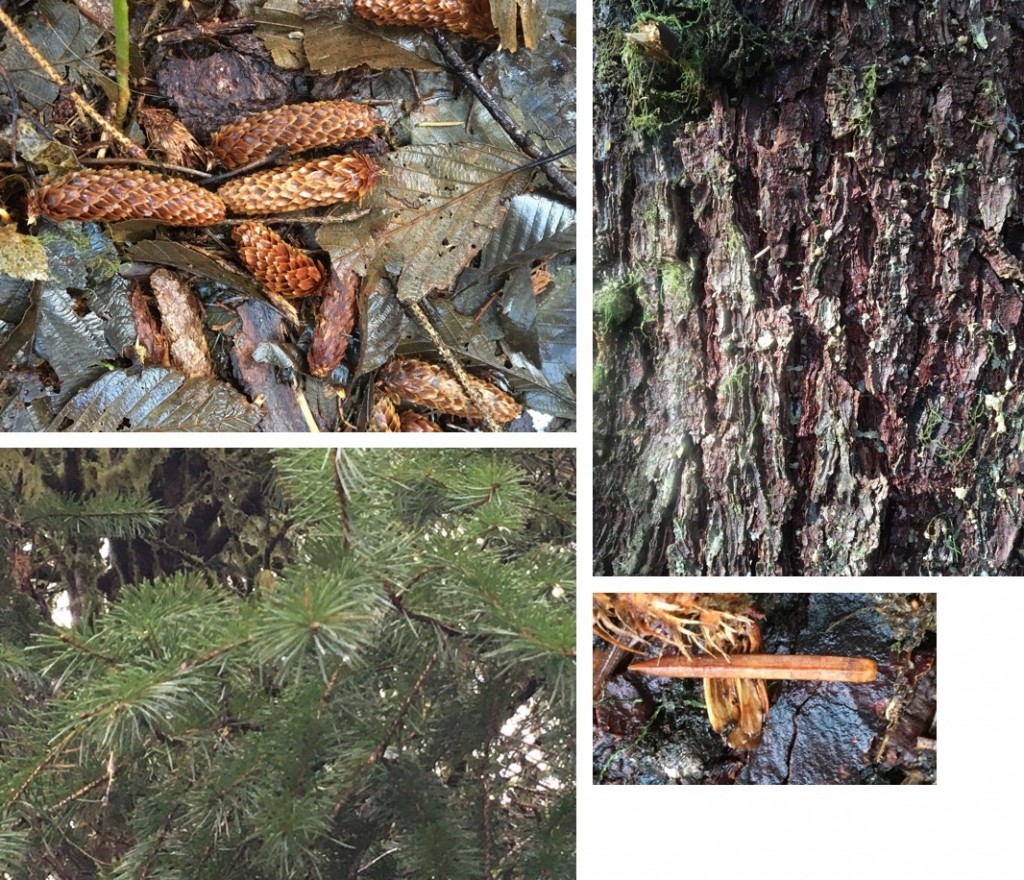
Holly and Oregon Grape

Red Alder
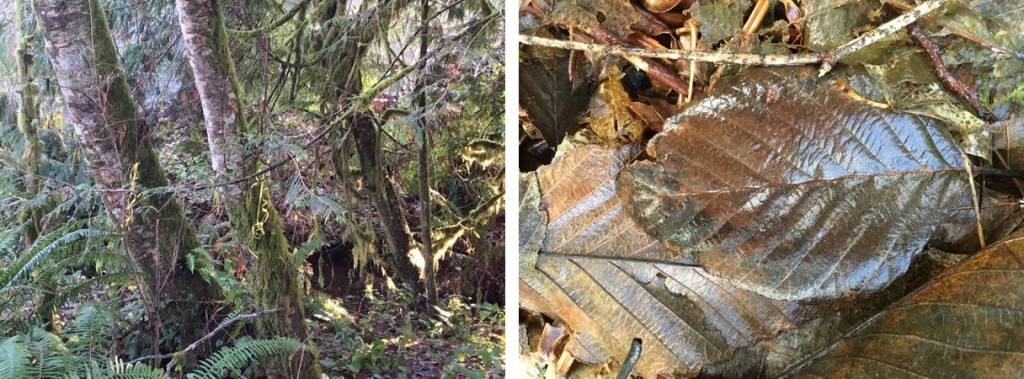
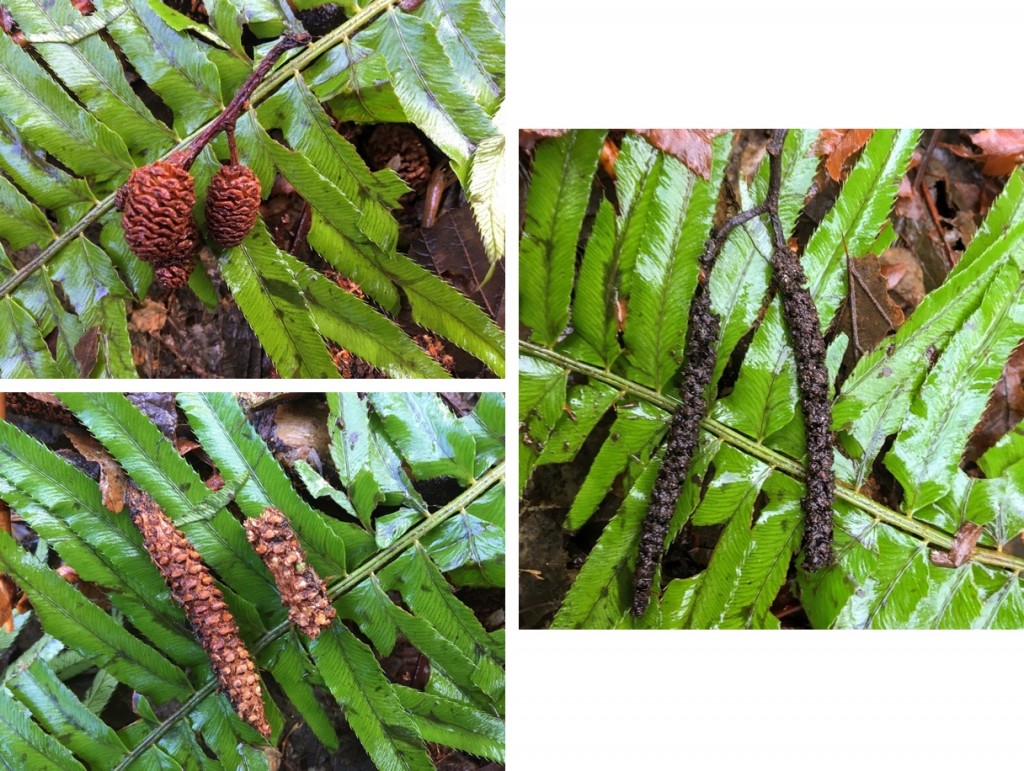
Vine Maples
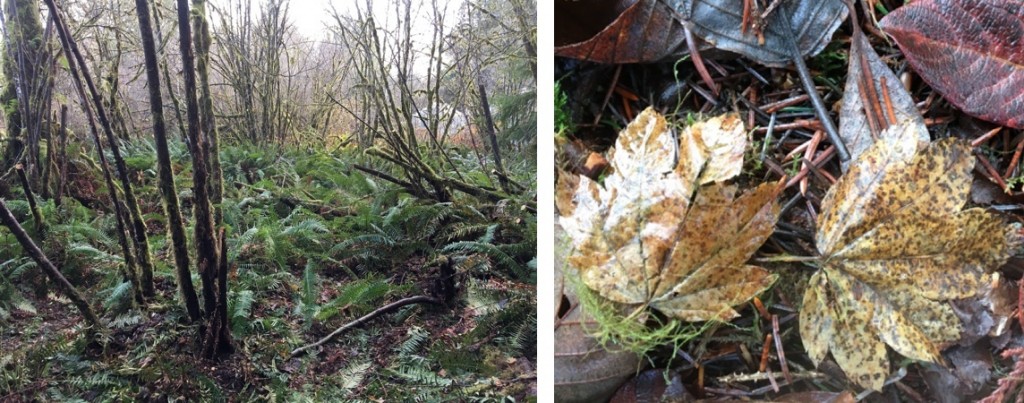
Salal
